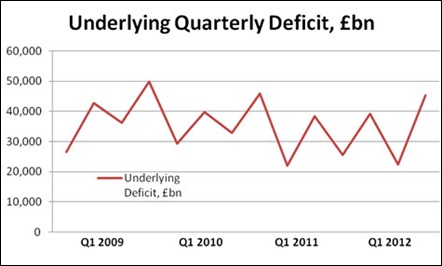The incredible shrinking UK economy – an updateBy John Ross
Earlier this year this blog published an article entitled ‘The Incredible Shrinking UK Economy’. It noted: ‘The magnitude of the blow suffered by the UK economy since the beginning of the financial crisis is very considerably minimized by not presenting it in terms of a common international yardstick. Gauged by decline in GDP, using a common international purchasing measure, dollars, no other economy in the world has shrunk even remotely as much as the UK.’ .
Data at that time was only available up until the end of 2010. Since then the World Bank has updated its data to cover 2011 and the pattern remains the same.
Taking first the situation of the world’s major economies, the G7 and BRICS, this is summarised in Table 1. The comparison made is between the last year before the financial crisis started, 2007, and the last available comprehensive international data – for 2011. As may be seen the $381 billion decline, in current dollar terms, of UK GDP is, without comparison, the worst of any major economy – indeed it is easily the worst in the world. As a percentage of world GDP the UK lost 1.6 percentage points – easily the worst performance of any European economy. The advance of all BRICS economies is also clear from this data.
Taking the situation within Europe this is shown in Table 2. As the UK, Ireland, and Iceland are the three economies which have suffered the biggest losses in GDP in dollars during the financial crisis this table may also be taken to show the ‘sin bin’ of world economic performance. The way in which the UK economy has declined in absolute terms far more than any other European economy is again evident.
Where does this leave the UK in the world rankings of economies? In terms of current dollar exchange rates. as shown in Table 3, the UK has slid from 5th to 7th position under the impact of the international financial crisis – being overtaken by France and Brazil
However, as is well known, current exchange rates substantially understate the size of developing economies compared to calculations in internationally equivalent prices (Parity Purchasing Powers – PPPs). This is particularly strikingly the case for India which at current exchange rates is only ranked 10th but in terms of PPPs in 2011 overtook Japan to rank as the world’s 3rd largest economy . In PPPs the UK has declined from 7th to 9th position – also being overtaken by France and Brazil on this measure.
The data is therefore clear. In terms of its real international position the decline in the position of the UK is by far the worst of any major economy. There is no reason to change the analysis. In terms of international comparisons the UK’s is truly ‘the incredible shrinking economy’
* * *
This article originally appeared on the blog Key Trends in Globalisation.


Recent Comments